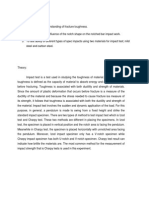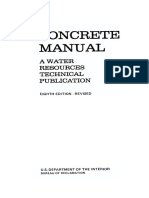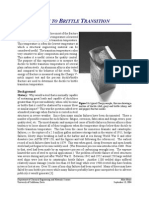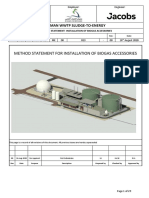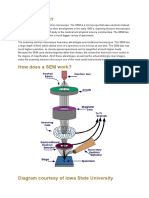Discussion Tensile
Discussion Tensile
Uploaded by
Harsha MadushanCopyright:
Available Formats
Discussion Tensile
Discussion Tensile
Uploaded by
Harsha MadushanOriginal Title
Copyright
Available Formats
Share this document
Did you find this document useful?
Is this content inappropriate?
Copyright:
Available Formats
Discussion Tensile
Discussion Tensile
Uploaded by
Harsha MadushanCopyright:
Available Formats
REVIEW QUESTION
1) Discuss the experimental errors that could have occurred during the test.
In this experiment we have found a value for Young’s Module of mild steel
by using tensile test apparatus. When we did this experiment, we have found
some errors and identified reason of that errors.
We have to rotated rotate wheel in unique speed to find the ultimate tensile
load of failure of the specimen. This step was done manually by us using hands.
Therefore, we could not rotate in unique speed and it was affected to the graph
which given in the programme. We got measurements by using vernier caliper
and pragramme. When we got measurements after broken peace of mild steel in
vernier caliper is verry difficult to measured final length and diameter of broken
cross section In this experiment. Also, the vernier caliper may be have zero errors
as well as human errors were included in the measurements. Those things were
affected to the final experimental values.
2) Explain the difference between brittle and ductile materials.
Ductile materials can withstand large plastic deformation before fracture,
but brittle materials can only withstand little plastic deformation. The percentage
elongation of ductile materials before breakage is higher in tensile testing. Brittle
materials have a low percentage of elongation before breakage in tensile testing.
Ductile materials fail gradually as a result of the creation of a neck under external
tensile pressure, whereas brittle materials break suddenly. Under tensile testing,
ductile materials absorb more energy before fracture, whereas brittle materials
absorb very little energy before fracture. On ductile materials, a variety of metal
forming procedures may be carried out, however on brittle materials, such
operations are difficult to carry out. When fatigue loading is applied, ductile
materials have a longer life span, while brittle materials break more quickly.
3) Compare and discuss the duality of mild steel and aluminum.
When comparing the total strength of steel and aluminum, the former
comes out on top. Although mild steel is technically stronger than aluminum, the
latter is sometimes much lighter. Steel, on the other hand, has a high percentage
of carbon, which contributes to its overall strength advantage.
Mild steel will have a density 2.5 times that of aluminum. Steels that are
lighter than carbon steels, such as mild steel, are available. Mild steels, on the
other hand, are not as robust as aluminum and are more prone to fractures and
cracks. When it comes to corrosion resistance, aluminum is extremely corrosion
resistant and does not require any additional treatments after extrusion.
Aluminum is shielded from the elements by a naturally occurring oxide coating.
4) State the difference between Secant modulus of elasticity and tangential
modulus of elasticity
The tangent modulus is given by the slope of the stress-strain curve at any
specified point. This is used for both plastic and elastic region. Below the
proportional limit the tangent modulus is useful in describing the behavior of
materials which have been stressed beyond the elastic region. Secant modulus is
the slope of the line which joining a point on the stress-strain in curve to the origin
of the axis. This is used for liner or non-liner elastic region only.
You might also like
- The Well Meadows Hospital Case Study SolutionDocument11 pagesThe Well Meadows Hospital Case Study SolutionLongNguyễn33% (3)
- Impact Test Lab ReportDocument5 pagesImpact Test Lab Reportaisyah mohamad othman85% (72)
- Laboratory Experiment 1.3Document6 pagesLaboratory Experiment 1.3Wes FerrerNo ratings yet
- Hardness Test On Low Carbon Steel and AluminiumDocument11 pagesHardness Test On Low Carbon Steel and AluminiumFara Najwa50% (2)
- Interview Quesions For BenzDocument5 pagesInterview Quesions For BenzSarfaraz Nawaz ShahaNo ratings yet
- Concrete Manual 8th Edition (USBR)Document661 pagesConcrete Manual 8th Edition (USBR)great_triskelion100% (10)
- Multi Mod Al Dang Goods MM DG FormDocument4 pagesMulti Mod Al Dang Goods MM DG Formravi vermaNo ratings yet
- Engineering Instrumentation Lab Report 2Document6 pagesEngineering Instrumentation Lab Report 2Rob JohnsonNo ratings yet
- Tensile ReportDocument18 pagesTensile ReportHafsa KhanNo ratings yet
- Fastener Materials and NomenclatureDocument16 pagesFastener Materials and NomenclatureabhiNo ratings yet
- Unit 21: Materials Engineering: Unit Code: F/601/1626 QCF Level: 4 Credit Value: 15Document20 pagesUnit 21: Materials Engineering: Unit Code: F/601/1626 QCF Level: 4 Credit Value: 15Jo okNo ratings yet
- Chapter4 150109005052 Conversion Gate02Document56 pagesChapter4 150109005052 Conversion Gate02زهديابوانسNo ratings yet
- Introduction To Composite Materials: Mr. S. G. KulkarniDocument66 pagesIntroduction To Composite Materials: Mr. S. G. KulkarniNavneet SoniNo ratings yet
- Steelcv DDocument5 pagesSteelcv DJinyan YangNo ratings yet
- Lab Impact TestDocument11 pagesLab Impact TestAmalinaAznanNo ratings yet
- SteelDocument5 pagesSteelAnaliza Divine HernandezNo ratings yet
- MO 201 Mechanical BehaviourDocument68 pagesMO 201 Mechanical BehaviourRashmiNo ratings yet
- Steel Quality ControlDocument9 pagesSteel Quality ControlLuigi BoardNo ratings yet
- Study Materials For Mechanical EngineersDocument63 pagesStudy Materials For Mechanical EngineersOmprakash ManharNo ratings yet
- Chapter 4 - MATERIAL TESTINGDocument48 pagesChapter 4 - MATERIAL TESTINGتاج نيسهاNo ratings yet
- Automotive Engine Components DesignDocument15 pagesAutomotive Engine Components DesignSathistrnpcNo ratings yet
- Impact TestDocument5 pagesImpact Testosama.ammer2002No ratings yet
- Mechanics of Materials Lab Fall 2018Document52 pagesMechanics of Materials Lab Fall 2018Hammad RazaNo ratings yet
- Mechanics of Materials Lab Fall 2018Document52 pagesMechanics of Materials Lab Fall 2018Hammad RazaNo ratings yet
- Engineering Materials and Metallurgy 2 Mark With AnswersDocument31 pagesEngineering Materials and Metallurgy 2 Mark With AnswersbrindharajasekarNo ratings yet
- Topic 2 Revised CMDocument31 pagesTopic 2 Revised CMO. L. K. (On)No ratings yet
- Drilling Operations l3 NotesDocument21 pagesDrilling Operations l3 Notesishimwe kwizera willyNo ratings yet
- EM ReportDocument22 pagesEM ReportAhmad Fakhrie ShahNo ratings yet
- 1 B) Unit - Mechanical Properties & Their TestingsDocument44 pages1 B) Unit - Mechanical Properties & Their TestingsAnil ChauvanNo ratings yet
- Mos-I Lab Manual PDFDocument31 pagesMos-I Lab Manual PDFFArzand E GulNo ratings yet
- PMT Sifat MaterialDocument67 pagesPMT Sifat MaterialFrislyNo ratings yet
- Ultimate Tensile Strength - Wikipedia, The Free EncyclopediaDocument5 pagesUltimate Tensile Strength - Wikipedia, The Free EncyclopediaAr Rupam KhungerNo ratings yet
- Structure of MetalsDocument6 pagesStructure of MetalsRheatot BiacoraNo ratings yet
- Material Testing MethodsDocument6 pagesMaterial Testing MethodsFebrian JhaNo ratings yet
- Mechanics of Materials Lab Lab #1 Tension Test of Metals Lab January 28, 2011 Team AluminumDocument9 pagesMechanics of Materials Lab Lab #1 Tension Test of Metals Lab January 28, 2011 Team Aluminumpianoplyr24No ratings yet
- EmmDocument18 pagesEmmrajasamygopalNo ratings yet
- Topic 3 - Material ScienceDocument17 pagesTopic 3 - Material ScienceYuvaraj Maganathan100% (1)
- Design of Steel and Timber Structures Examples PDFDocument78 pagesDesign of Steel and Timber Structures Examples PDFsamson100% (3)
- Experimental Study of Tensile Testing of Metallic Materials in Engineering MechanicsDocument4 pagesExperimental Study of Tensile Testing of Metallic Materials in Engineering Mechanicsishtiaq raoNo ratings yet
- Mech Tests (1)Document41 pagesMech Tests (1)Sarvjeet BachhalNo ratings yet
- ME136P-2 Experiment 1.3 AporaDocument6 pagesME136P-2 Experiment 1.3 AporaErol Josef AporaNo ratings yet
- TORSION OF BARS Lab Sheet 2Document6 pagesTORSION OF BARS Lab Sheet 2mrsmartguysNo ratings yet
- Ductile Brittle TransitionDocument7 pagesDuctile Brittle Transitionssnathan794508No ratings yet
- Material Science For CTTC BBSR 07 Oct 2022Document149 pagesMaterial Science For CTTC BBSR 07 Oct 2022Nishant ThapliyalNo ratings yet
- Engineering Materials NewDocument11 pagesEngineering Materials Newnihar0008No ratings yet
- Mech Property TestingDocument103 pagesMech Property TestingShivanand ArwatNo ratings yet
- Emm Question Bank Unit3Document3 pagesEmm Question Bank Unit3MANOJ MNo ratings yet
- Week 3 Elastic Strength and Failures of MaterialsDocument11 pagesWeek 3 Elastic Strength and Failures of MaterialsSamantha NamzugNo ratings yet
- ME136P-2 Experiment 1.2 AporaDocument7 pagesME136P-2 Experiment 1.2 AporaErol Josef AporaNo ratings yet
- 600+ TOP MECHANICAL ENGINEERING Interview Questions & AnswersDocument37 pages600+ TOP MECHANICAL ENGINEERING Interview Questions & AnswersNikhil Prasanna100% (1)
- CLO1 - Mechanical Properties of Materials Used in The Maritime IndustryDocument11 pagesCLO1 - Mechanical Properties of Materials Used in The Maritime IndustryEzy WaqaNo ratings yet
- komba 1Document51 pageskomba 1juniorjrjohansen10No ratings yet
- Orthodontic WiresDocument116 pagesOrthodontic WiresAyad Taha100% (2)
- Ferrous MetalDocument26 pagesFerrous MetalEdbert TulipasNo ratings yet
- MM 1st Lab ReportDocument11 pagesMM 1st Lab ReportIbrahim AfridiNo ratings yet
- MW 333 Practicals 1-9Document37 pagesMW 333 Practicals 1-9abdixardarNo ratings yet
- LO2 Structural Mechanical Prop Metals PDFDocument41 pagesLO2 Structural Mechanical Prop Metals PDFChelle VillasisNo ratings yet
- Mechanical Properties of MaterialDocument3 pagesMechanical Properties of MaterialAngel Ange P PhiriNo ratings yet
- Encyclopaedia Britannica, 11th Edition, Volume 6, Slice 8 "Conduction, Electric"From EverandEncyclopaedia Britannica, 11th Edition, Volume 6, Slice 8 "Conduction, Electric"No ratings yet
- Innovation and InventionDocument1 pageInnovation and InventionHarsha MadushanNo ratings yet
- DISCUSSIONDocument4 pagesDISCUSSIONHarsha MadushanNo ratings yet
- DISCUSSIONDocument3 pagesDISCUSSIONHarsha MadushanNo ratings yet
- Discussion Part CDocument8 pagesDiscussion Part CHarsha MadushanNo ratings yet
- Discussion Part BDocument1 pageDiscussion Part BHarsha MadushanNo ratings yet
- Discussion SFD and BMDDocument1 pageDiscussion SFD and BMDHarsha MadushanNo ratings yet
- LS EHV Cable System EN 0907 PDFDocument64 pagesLS EHV Cable System EN 0907 PDFbalwant_negi7520No ratings yet
- History of The BoltDocument3 pagesHistory of The BoltGray Fox GarcíaNo ratings yet
- Es8012en WebDocument56 pagesEs8012en WebrotkviceNo ratings yet
- Description Page Number: QUEST - Power Coaching For IITJEEDocument35 pagesDescription Page Number: QUEST - Power Coaching For IITJEEAkshit AgarwalNo ratings yet
- Theory of Structures - IVDocument2 pagesTheory of Structures - IVTSEYSETSENo ratings yet
- Catalogo Dbi Sala 2016Document212 pagesCatalogo Dbi Sala 2016Moises Castillo Guerrero100% (1)
- Punchless Punching of Thin Sheet Metal by Ultrahigh Pressure Gas For Circular HoleDocument10 pagesPunchless Punching of Thin Sheet Metal by Ultrahigh Pressure Gas For Circular HoleManolo GipielaNo ratings yet
- R8C25 DatasheetDocument59 pagesR8C25 DatasheetcoolhatNo ratings yet
- Asme Section II A-2 Sa-592 Sa-592mDocument4 pagesAsme Section II A-2 Sa-592 Sa-592mAnonymous GhPzn1xNo ratings yet
- ASP SST Fittings DataCatalog-1013Document16 pagesASP SST Fittings DataCatalog-1013JMNo ratings yet
- Fluorescent: Code Watt Lamp Cap Lumen Tube Length MM Color Rendering Index Osram CodeDocument2 pagesFluorescent: Code Watt Lamp Cap Lumen Tube Length MM Color Rendering Index Osram CodeKhaled RabeaNo ratings yet
- Massey Ferguson MF 145 TRACTOR Service Parts Catalogue Manual (Part Number 957180)Document15 pagesMassey Ferguson MF 145 TRACTOR Service Parts Catalogue Manual (Part Number 957180)bvk2980022No ratings yet
- Videocard BenchmarkDocument17 pagesVideocard Benchmarkangelic hansNo ratings yet
- 48x8 Scrolling Matrix Led Display Using Arduino CoDocument6 pages48x8 Scrolling Matrix Led Display Using Arduino CoJeeva NandhamNo ratings yet
- Caledonian: European Installation Bus (EIB) CablesDocument3 pagesCaledonian: European Installation Bus (EIB) Cablesrose chenNo ratings yet
- Software Quality and TestingDocument35 pagesSoftware Quality and Testingmca.tarun100% (1)
- Fisa Tehnica PEAD-MDocument3 pagesFisa Tehnica PEAD-MStefan StanciuNo ratings yet
- BLD 112 Lecture NoteDocument42 pagesBLD 112 Lecture NoteUmar Bello NuhuNo ratings yet
- Proposals For Double Lane Roads in Rajanna Sircilla District As On 09.10.2017Document3 pagesProposals For Double Lane Roads in Rajanna Sircilla District As On 09.10.2017Srinivas PNo ratings yet
- Aadhaar Authentication API 1 5 Rev2Document33 pagesAadhaar Authentication API 1 5 Rev2parag_2k6No ratings yet
- Purpose of Equipotential BondingDocument3 pagesPurpose of Equipotential BondingAreeb Waseem100% (1)
- XBA-SAR4 (Pulse+MDB+ICT+Parallel A3) PDFDocument1 pageXBA-SAR4 (Pulse+MDB+ICT+Parallel A3) PDFVasil StoyanovNo ratings yet
- MST of Installation of BiogasDocument29 pagesMST of Installation of BiogasJayakrishnan RadhakrishnanNo ratings yet
- Specification CEFO G2 - ENDocument15 pagesSpecification CEFO G2 - ENLeo Gamarra LanguideyNo ratings yet
- Weather Stopper Ii Sti-3150-BreakDocument2 pagesWeather Stopper Ii Sti-3150-BreakvlinemubeenNo ratings yet
- 2018-04-05 PraDocument143 pages2018-04-05 PraJoe EskenaziNo ratings yet
- What Is A SEMDocument4 pagesWhat Is A SEMJunaid AfzalNo ratings yet


